 |
|
پی سی سیتی
> سایر گفتگوها
> ورزش Sports
|
 تیراندازی با کمان، تاریخچه کمانداری، اصول و قوانین تیراندازی با کمان، آموزش تیراندازی با کمان، معرفی رشته های ریکرو و کامپوند
تیراندازی با کمان، تاریخچه کمانداری، اصول و قوانین تیراندازی با کمان، آموزش تیراندازی با کمان، معرفی رشته های ریکرو و کامپوند
|
|
|
| ورزش Sports در این تالار به مباحث عمومی ورزش و اخبار رشته های مختلف آن پرداخته میشود |

08-01-2013
|
 |
کاربر کارآمد
|
|
تاریخ عضویت: Feb 2010
محل سکونت: کرمانشاه- همین حوالی
نوشته ها: 731
سپاسها: : 247
554 سپاس در 357 نوشته ایشان در یکماه اخیر
|
|
 نمونه هایی از تمرین با وزنه جهت تقویت عضلات شانه(جانبی،پشت؛جلو)در تیر اندازی با کمان
نمونه هایی از تمرین با وزنه جهت تقویت عضلات شانه(جانبی،پشت؛جلو)در تیر اندازی با کمان
نمونه هایی از تمرین با وزنه جهت تقویت عضلات شانه(جانبی،پشت؛جلو)در تیر اندازی با کمان
عضلات شانه ( جانبی ، پشت ، جلو ) یکی از عضلات اصلی در ورزش تیر اندازی با کمان می باشد که عدم گرم کردن آنها قبل از تمرینات ، عدم تقویت آنها ودر نتیجه بی توجهی به این عضلات هنگام تمرینات باعث آسیب دیدگی انها می گردد .
در اینجا به چند حرکت ساده جهت تقویت آنها و گرم کردن قبل از شروع تمرینات اشاره می شود. سعی کنید حتما آنها را اجرا کنید
حرکت اول :
دستها از طرفین تا مقابل شانه ها بالا آمده و آمده و مجددا به آرامی پایین آمده و کنار بدن قرار می گیرد . ( البته به صورت دستهای کشیده هم اجرا می گردد که فشار بیشتری به عضلات جانبی شانه ها وارد میگردد ). این حرکت می تواند در تکرار های 12-10 ودر 3 ست تکرار شود
حرکت دوم :
دست راست بر روی شانه چپ قرار گرفته و پنچه دست چب با گرفتن آرنج دست راست ، دست راست را تا آخرین حد که دست اذیت نگردد کشیده و به مدت 15-12 ثانیه ثابت نگه داشته و سپس دستها عوض شود . این آخرین حد که دست اذیت نگردد .عمل باعث جریان خون بیشتر و کشش عضلات دست و شانه ها می گردد
حرکت سوم :
کشش دستها از پشت که در تصویر زیر حرکت کاملا مشخص است .این حالت هم می تواند با 15 ثانیه مکث اجرا گردد و سپس تغییر کند
حرکت چهارم :
این حرکت همانند حرکت اول است با این تفاوت که اولا دستها کشیده و ثانیا با دمبل اجرامی گردد
این حرکت می تواند در تکرار های 12-10 و در 3 ست اجرا گردد
حرکت پنجم :
سرشانه دمبل خوابیده به یکطرف.

|
|
کاربران زیر از چرو به خاطر پست مفیدش تشکر کرده اند :
|
|
|
جای تبلیغات شما اینجا خالیست با ما تماس بگیرید
|
|

08-01-2013
|
 |
کاربر کارآمد
|
|
تاریخ عضویت: Feb 2010
محل سکونت: کرمانشاه- همین حوالی
نوشته ها: 731
سپاسها: : 247
554 سپاس در 357 نوشته ایشان در یکماه اخیر
|
|
 تعریف پنداژ کمان
تعریف پنداژ کمان
تعریف پنداژ کمان
نیرویی که برای کشیدن کمان در طول کشش ۷۱۰ میلیمتر(۲۸ اینچ) نیاز است پنداژ کمان میگویند این مقدار بر روی لیبل بازوی کمان نوشته شده است.
برد کمان بستگی به پنداژ آن دارد به طوری که هر چه پنداژ کمان بیشتر باشد مسافت و برد تیر کمان بیشتر می شود.
پنداژ کمان برای مبتدیان و آموزشی هست بین ۲۶-۲۰ پوند و جهت استفاده بزرگسالان ۳۰-۴۰ پوند و بین۲۰-۱۴ پوند جهت استفاده بچه ها
کمانهای ریکرو پایه که برای مبتدیان ساخته شده از بازوهای(لیمبهای) چوبی با روکش یا مواد پلاستیکی فایبر گلاس است که این بازوها در پنداژهای مختلف ساخته میشوند.
منبع: vahidh . blogfa . com
ویرایش توسط امیر عباس انصاری : 08-01-2013 در ساعت 04:05 PM
دلیل: منبع
|
|
کاربران زیر از چرو به خاطر پست مفیدش تشکر کرده اند :
|
|

08-01-2013
|
 |
کاربر کارآمد
|
|
تاریخ عضویت: Feb 2010
محل سکونت: کرمانشاه- همین حوالی
نوشته ها: 731
سپاسها: : 247
554 سپاس در 357 نوشته ایشان در یکماه اخیر
|
|
 تنظیم تیلر و(پنداژ) پونداژ كمان
تنظیم تیلر و(پنداژ) پونداژ كمان
تنظیم تیلر و پونداژ كمان
اكثر كمانهای جدید دارای قابلیت تنظیم پونداژ هستند كه این عمل خود باعث تغییر تیلر نیز میشود .
برای تغییر پونداژ/تیلر كافی است از یك آچار آلن استفاده كنیدو پیچ هر لیمب را سفت یا شل كنید.برای افزایش پونداژ پیچ را سفت و برای كاهش آن پیچ را شل میكنیم .
به صورت ایده آل پونداژ كمان باید در حالت متوسط باشد .
تیلر اندازه ای است كه بیانگر تفاوت پونداژ بین لیمب بالا و پایین است.اهمیت تیلر به این خاطر است كه گریپ كمان (محل تماس دست با قبضه)معمولا در مركز كمان قرار دارد در حالیكه رست و ناكینگ پوینت بالای مركز واقع شده اند.این بدان معنی است كه لیمب پایین بلند تر از لیمب بالا است و باید برای داشتن خمیدگی هماهنگ در كشش كامل دارای پونداژ بیشتری باشد .
تفاوت بین تیلر بالا و پایین بر عكس العمل كمان هنگام ریلیز و توانایی كماندار برای هدفگیری و ثابت نگه داشتن كمان در حالت كشش كامل تاثیر میگذارد .
میزان تیلر با توجه به عواملی مثل فشار گریپ فشار انگشت و ...بین كمانداران مختلف متفاوت است .
برای شروع تیلر بالا را 1/8 اینچ بیشتر از تیلر پایین قرار دهید .
برای تنظیم تیلر ابتدا پونداژ كمان را در حالت متوسط قرار دهید و سپس تیلر كمان را مانند شكل بالا چك كنید و به خاطر داشته باشید كه میخواهیم اندازه تیلر بالا بیشتر از پایین باشد .
حال برای به دست آوردن تیلر دلخواه پیچهای لیمب را به سمت داخل یا بیرون بپیچانید.انجام این عمل میتواند پونداژ كمان را نیز تغییر دهد.پس برای ثابت نگاه داشتن پونداژ پیچ لیمب دیگر را نیز به همان مقدار ولی در جهت عكس بچرخانید.مثلا اگر پیچ بالا را یك دور به سمت چپ چرخاندید پیچ پایین را یك دور به سمت راست بچرخانید .
این عمل اندازه تیلر را تغییر میدهد اما با پونداژ كمان كاری ندارد زیرا پونداژ را از روی یك لیمب برداشته و به لیمب دیگر اضافه میكند .
همیشه در هنگام انجام این تغییرات از دستورالعملهای سازنده كمان پیروی كنید.بعضی كمانها را میتوان در حالتی كه زه روی آنها نصب است تنظیم كرد اما بعضی دیگر حتما باید بدون نصب زه تنظیم شوند

|
|
کاربران زیر از چرو به خاطر پست مفیدش تشکر کرده اند :
|
|

08-13-2013
|
 |
کاربر کارآمد
|
|
تاریخ عضویت: Feb 2010
محل سکونت: کرمانشاه- همین حوالی
نوشته ها: 731
سپاسها: : 247
554 سپاس در 357 نوشته ایشان در یکماه اخیر
|
|
 10 مرحله تا پرتاب
10 مرحله تا پرتاب
The following sequence of figures shows the basic steps of shot execution. Although it is depicted as a sequence of separate events, you should execute these steps in one single smooth motion. Also keep in mind that these are Basic steps, individual adjustments are possible, but these are usually given by the instructor / trainer.
Step:1 Stance
* Put the tip of your toes against an imaginary straight line towards the centre of the target.
* Put your feet on both sides of the line. Put your feet about shoulder’s width apart. Try and relax.
Step 2: Finger Placement
* Place your fingers in such a way, that you hold the string with your index finger above the nock and your middle and ring finger under the nock.
* Hook the string between the first and second joint. Make sure that you maintain a deep hook.
Step 3: Bow Hand Placement
* The pressure of the bow should be distributed along the pressure line.
* The tips of your thumb and index finger may touch each other in a relaxed way.
Step 4: Extending the bow arm
* Bring the bow arm to shoulder height.
* The elbow of the bow arm should be turned away from the string.
Step 5: Drawing the Bow
Draw the string along the bow arm
* Draw the string along the bowarm in a straight horizontal line to the anchor point.
* Draw with your back muscles, moving the shoulder blades towards each other.
* Stand straight up and relaxed.
* Keep both shoulders as low as possible.
Step 6: Anchoring
* The string should touch the middle of the chin.
* The index finger is placed under the chin.
* Keep your theeth together.
Step 7: Holding
* Keep your back muscles under tension.
* Bow hand, draw hand and albow should form a straight line.
* Keep both the shoulders as low as possible.
Step 8: Aiming
* Aiming is done with the dominant eye. Shut the other eye.
* Keep the sight at the target.
* Keep the string a little left of the sight
Step 9: Release
* Keep pulling the shoulder blades towards each other, while relaxing the fingers of the draw hand
* A relaxed bow hand will automatically move backwards.
* Relax your bow hand. Let the bow drop.
Step 10: Follow Through
* The draw hand should be relaxed and near or behind your ear.
* Keep aiming untill after the arrow hits the target.
منبع:
Ten Basic Steps in Archery

|
|
کاربران زیر از چرو به خاطر پست مفیدش تشکر کرده اند :
|
|

08-16-2013
|
 |
کاربر کارآمد
|
|
تاریخ عضویت: Feb 2010
محل سکونت: کرمانشاه- همین حوالی
نوشته ها: 731
سپاسها: : 247
554 سپاس در 357 نوشته ایشان در یکماه اخیر
|
|
 کیوجوتسو - هنر تیر و کمان سامورائی
کیوجوتسو - هنر تیر و کمان سامورائی
کيو جوتسو ( هنر تيراندازي با کمان ) , هنر رزمي سنتي ژاپني که توسط سامورايي ها ژاپن فئودال استفاده ميشد , آنها با استفاده از يک کمان ( يومي Yumi ) اين هنر باستاني را تمرين ميکردند . گر چه ممکن است يک سامورايي به عنوان بهترين شمشيرزن با کاتانا ( کن جوتسو ) شناخته شود, اما در واقع " کيو جوتسو " يک مهارت بسيار مهم و حياتي است که براي بخش عمده ايي از تاريخ ژاپن در نظر گرفته ميشود.
در بيشتر دوره " کاماکورا " و تمام دوره " موروماچي " ( 1185 - 1568 ) , کمان به عنوان نمادي از جنگجو سلحشور بوده , و راه زندگي جنگجو مرتبط است با " راه کمان و اسب " ( کيوبا نو ميچي Kyuba No Michi ) .
" پيشرفت و تمرين "
يکي از قديمي ترين مدارس رسمي " کيو جوتسو Kyujutsu " , که در قرن 14 تاسيس شد , " اوگاساوارا - ريو Ogasawara - Ryu " بود , اين مدرسه هنر تيراندازي با کمان را به صورت علمي تدريس ميکرد . به خصوص اينکه , تمرين تيراندازي با کمان در حين سوارکاري با اسب ( يابوسامه Yabusame ) را توسعه داد و آموزش گسترده ايي در اين زمينه به انجام رساند . کمان ( يومي ) در شکلي نامتقارن و اندازه ايي نسبتا بزرگ در آن زمان غير معمول بوده , " يومي " در اندازه هاي مختلفي ساخته ميشود , گاهي اوقات کمي کمتر از 6 فوت و گاهي اوقات کمي بيشتر از 7 فوت طول دارد ( هر فوت 30 سانتي متر مي باشد ) و تنها در يک سوم پاييني آن جايگاهي براي به دست گرفتن کمان تعبيه شده است . در زمان اوج استفاده از " يومي " , آنها را با ترکيبي از چوب و چوب خيزران ( بامبو ) ميسازند , همچنين مانند کمان نيز سر تيرهاي مختلفي ساخته ميشود که هر کدام از آنها در مراسمات و برنامه هاي مخصوصي به کار برده مي شود . آموزش شامل 1000 بار تيراندازي با کمان در هر روز , استفاده از تکنيک هاي توسعه يافته با تمرکزي بالا در مراحل مختلف تيراندازي و همچنين نگرش ذهني مورد نياز براي هر مرحله تيراندازي است . علاوه بر اين ها , انجام بسياري از تاکتيک هاي تخصصي براي گروه هاي تيرانداز مي باشد .
" کاهش محبوبيت و تمرينات مدرن "
در سال 1543 تفنگ فتيله ايي به ژاپن معرفي شد , ديري نگذشت که ژاپن شروع به ساخت تفنگ فتيله ايي با نام " تانه گاشيما Tanegashima " کرد و تاکيد بر روي کسب مهارت در هنر " کيو جوتسو " به تدريج کاهش يافت , به طوريکه " تانه گاشيما " و " ياري " ( نيزه سنتي ژاپني ) به سلاح هاي اصلي جنگ مبدل گشتند . در نهايت هنر " کيو جوتسو " به سبکي مدرن و امروزي به نام " راه کمان " ( کيودو Kyudo ) تبديل شد , سبکي که امروزه آن را تمرين مي کنند .
( به کوشش مصطفی پروار )

|

08-16-2013
|
 |
کاربر کارآمد
|
|
تاریخ عضویت: Feb 2010
محل سکونت: کرمانشاه- همین حوالی
نوشته ها: 731
سپاسها: : 247
554 سپاس در 357 نوشته ایشان در یکماه اخیر
|
|
 کیودو، هنر کمانگیری ژاپنی
کیودو، هنر کمانگیری ژاپنی
کیودو، هنر کمانگیری ژاپنی
کیودو (Kyudo) هنر کمانگیری ژاپنیست که قدمتی بسیار کهن دارد. تاریخ این طریقت، همواره با افسانهها و اسطورههای سرزمین آفتاب تابان همراه بوده و امروزه این هنر، یکی از هنرهای بسیار مهم و اصیل ژاپن محسوب میشود.
تاریخنگاران، بنابر دستاوردهای باستان شناسی و جمع آوری وقایع نامهها و گاهشمارهای باستانی، عموماَ سیر تحولات و تکامل هنر کیودو را به پنج بخش تاریخی در ژاپن تقسیم میکنند که عبارت است از: دوره پیش از تاریخ (7000 قبل از میلاد تا 330 میلادی)، دوره باستانی (330 تا 1192 میلادی)، دوره فئودالی یا ملوک الطوایفی (1192 تا 1603 میلادی)، دوره انتقالی (1603 تا 1912 میلادی) و دوران معاصر (1912 میلادی تا زمان حاضر).
آنگونه که مشهود است، استفاده از تیر و کمان در ژاپن، همانند بسیاری از تمدنهای باستانی دیگر، قدمتی بسیار زیاد داشته و به عصر انسانهای بدوی باز میگردد. این ابزار در دورانهای پیش از تاریخ، وسیله ای برای شکار حیوانات و پرندگان بوده و نیز در جنگهای قبیله ای کاربرد داشته و رفته رفته تکامل یافته و در دورانهای تاریخی ژاپن، علاوه بر کابرد در شکار، عموماَ در جنگها مورد مصرف بوده است و در طول دورهی تاریخی ژاپن، بیشتر به عنوان یک سلاح جنگی کاربرد داشته. امروزه این ابزار به یک وسیلهی ورزشی بدل شده و هنر استفاده از آن در ژاپن کیودو نامیده میشود که معنای آن راه کمانگیری ست.
برآورد میشود که امروزه بیش از نیم میلیون هنرجوی کیودو، در این هنر رزمی به فعالیت مشغولند. در ژاپن تخمین زده شده که نیمی و یا شاید بیشتر از نیمی از هنر جویان کیودو را بانوان تشکیل میدهند.
کمان ژاپنی یا یومی (Yumi)، کمانی استثنایی با طول غیر معمول در حدود دو متر است یعنی طولی عموماَ بیشتر از قامت یک هنرجوی کیودو یا یک کیودوکا (Kyudoka).
یومی در زمانهای باستان، از خیزران یا بامبو (Bamboo)، چوب و چرم ساخته میشد. امروزه علاوه بر یومیهایی که به همان سبک سنتی ساخته میشوند، یومیهایی با مواد مصنوعی جدید نیز تولید میشود و مورد کاربرد هنرجویان است.
تیر یا خدنگی که توسط یومی پرتاب میشود یا (Ya) نام دارد و عموماَ از خیزران یا بامبو ساخته شده و البته امروزه از مواد مصنوعی و... نیز در ساخت آن استفاده میکنند. در زمانهای گذشته در انتهای تیرها، پر عقاب یا قوش میگذاشتند، اما امروزه در راستای حفظ پرندگان در حال انقراض و حفاظت محیط زیست، سازندگان تیرها، از پر قو یا بوقلمون استفاده میکنند.
تیرهای استفاده شده در هنر کیودو، اصطلاحاَ به دوگونه تقسیم میشوند: تیر نر یا هایا (Haya) و تیر ماده یا ئوتویا (Otoya). تیرهایی که جهت بافت تیر و پر آن در جهت عقربههای ساعت است هایا و تیرهایی که دارای بافت خلاف جهت عقربههای ساعت هستند ئوتویا نامیده میشوند. کیودوکا یا تیرانداز عموماً در هر راند تیراندازی دو تیر به سوی هدف پرتاب میکند و اولین پرتاب را با تیر هایا انجام میدهد.
هنرجویان کیودو برای تیر اندازی یک دستکش نیز به دست راست خود میکنند که یوگاکه (Yugake) نام دارد و از مواد گوناگون مانند پوست آهو تهیه میشود.
سیبل یا هدفی که تیر به سوی آن پرتاب میشود ماکیوارا (Makiwara) نام دارد و حصیری ست. هنرجویان کیودو برای شروع تمرین از مسافت بسیار نزدیک به هدف تیر میاندازند و به مرور این مسافت را افزایش میدهند. تیر اندازی از مسافت نزدیک به هدف، این امکان را به هنرجو میدهد تا با دقت، تمرکز و ظرافت بیشتری به پرتاب تیر همت گمارد. تکنیکهای استفاده از تیر و کمان در طریقت کیودو دارای قوانین و مقررات بسیار مهم و منظمیست. فدارسیون مرکزی کیودو ژاپن (ANKF) قوانین و مقررات ویژهای تحت عنوان هاستسو (Hassetsu) یا هشت مرحلهی پرتاب تیر را در نظام نامهی کیودو (Kyudo Kyohon) وضع کرده که تمامی هنرجویان موظف به رعایت این قوانین هستند که هریک از این مراحل، دارای دستور العملها و توضیحات خاصیست.
این هشت پایه عبارتند از:
1- آشیبومی(Ashibumi): محل استقرار و وضعیت پاها.
2- دوزوکوری (Dozukuri): شکل بدن.
3- یوگامائه (Yugamae): گرفتن کمان.
4- اوچیئوکوشی (Uchiokoshi): بالا بردن کمان.
5- هیکی واکه (Hikiwake): کشیدن آغازین کمان.
6- کای (Kai): کشیدن کامل کمان.
7-هاناره (Hanare): رها کردن تیر.
8- ذان شین (Zanshin): تعقیب پرتاب تیر و ایستایی ذهن و بدن تیرانداز.
این هشت مرحلهی پرتاب، هریک دارای متد، دستور العملها و قوانین خاص و ثابتی است که هنرجویان کیودو موظف به رعایت و پیروی از آن هستند.
تمرکز صحیح و قرار گرفتن در وضعیت مراقبه در هنگام تیراندازی، یکی از اصولی ترین بخشهای این هنر است. آرامش کیودوکا و مراقبه در حین پرتاب تیر، نیازمند تمرینها و ممارستهای ذهنی ست که هنرجویان پیش از انجام تمارین خود به تقویت آن میپردازند.
در این میان استفاده از روشهای مراقبه، کمک بسیار مفیدی ست برای هنرجویان. استفاده از روشهای طریقت باستانی ذن (Zen) در این راستا در زمانهای گذشته بسیار کاربرد داشته و امروزه نیز مورد توجه است. ذن مکتب بسیار دیرینه سالی ست که در چین تولد یافت و حدوداَ در قرن دوازدهم میلادی به ژاپن راه یافته و پیشرفتهای بسیاری کرد.
بسیاری از ساموراییها به سوی طریقت ذن سوق پیدا کرده و این مکتب در بسیاری از آداب و رسوم و هنرهای ژاپنی نفوذ کرد و فرهنگ ژاپن را تحت تأثیر خود قرار داد.
ذن در هنرهای رزمی از جایگاه ارزشمند و مهمی برخوردار بوده و امروزه نیز حضور آن بسیار مشهود است. هنر کیودو تنها یک ورزش یا تفریح نیست، بلکه این هنر، موجبات تجلی روح و روان فرد را فراهم آورده و تأثیری مستقیم بر زندگی و تفکرات یک کیودوکا به جای خواهد گذاشت.
کیودو نمادیست از فرهنگ، اصالت و ذهنیت مردمان ژاپن، مردمان سرزمین آفتاب تابان.

|

08-16-2013
|
 |
کاربر کارآمد
|
|
تاریخ عضویت: Feb 2010
محل سکونت: کرمانشاه- همین حوالی
نوشته ها: 731
سپاسها: : 247
554 سپاس در 357 نوشته ایشان در یکماه اخیر
|
|
 KYUDO EQUIPMENT CARE
KYUDO EQUIPMENT CARE
KYUDO EQUIPMENT CARE
by Dan Dayley
Those of us fortunate enough to appreciate kyudo know Shibata, Sensei has not only brought us an exceIlent practice but, as well, he has made available to us implements rich in tradition, power and beauty. These sacred implements are indeed worthy of our respect, appreciation, and mindfulness.
Because the practice of kyudo is path or ”way”, the process of learning about relating to equipment, to shooting and to our minds is life-long. Many details will, of course, be left to hands-on instruction by Sensei and his instructors.
There are several general guidelines for respectful handling of the yumi. It should be handled carefully; gently but firmly like a baby. It should be wrapped when stored and should never be exposed to moisture or extended periods of direct sunlight. When entering the dojo, the yumi should be held upright and in front of you. The yumi should pass through the entry first. As you exit the dojo, the yumi should be held the same way as when entering and should be in front of you as you bow. Yumi first when you enter and yumi last when you exit.
When your yumi is in your car, it should be situated feet forward, like a person. It’s easy if you always think of your yumi as another living thing.
When standing a yumi against a wall, make sure it is positioned in a secure way: bottom on the floor, and only the head of the yumi touching the wall. Never place the yumi in such a way that it will easily fall down when unattended. Sensei has instructed his students to kneel down on one knee both when removing a yumi from its standing position, as well as when placing it against a wall. The same respectful gesture applies to ya (ya are always placed ”tip to ground”).
It is improper to stand or carry a yumi upside down, or to step over a yumi when it is lying on the floor. Also, it is disrespectful to touch or handle another person’s yumi without their permission. Sensei has said this is like touching someone’s spouse.
After each shooting session, the yumi should be vigorously rubbed, top to bottom, with a soft leather or cotton cloth. to remove soil or grease.
Always take care of your own equipment. Neither expect someone else to take care of it for you, or presume that you can take care of someone else’s. ”Baby bottle style” is not so good.
FinaIly, cultivate your awareness in the dojo. It is a shrine and practice situation. See what is around you, not only with your eyes, but also with your mind, so you can avoid collisions with other people and their equipment, even if they are behind you (Sensei says ”mind look back”).
Proper care of equipment is all part of the mind polishing practice that Sensei has so patiently brought to this country.
CONTINUATION ON CARE OF YUMI, YA AND KAKE
by Marcia Shibata
The yumi can be equated with a fine hand made instrument like the violin or guitar. They are similar in that they are made of wood (the yumi is mostly bamboo but has some wood; bamboo has been called not wood or grass but both) pressed, glued, shaved, heated, bent and formed by hand and with the help of tools, until a beautiful, delicate and balanceed piece is produced. In the same light the yumi, as well as a good string instrument, must be handled with great care or it will twist, crack, break or some other undesirable state may befall it.
The yumi reacts to temperature, moisture or lack of moisture in the air, sunlight, harsh handling and gripping too strongly with the left hand.
Absolute ”don’t”s in handling the yumi
- Never shoot a yumi (twang the ’tsuru’ string) without a ya. You will break it. Once the yumi is broken no one can repair it.
- Never leave a yumi in the sunlight or near a source of heat. This will dry the yumi out. The drying is guaranteed to cause breakage.
- Never shoot your yumi full draw if its been sitting unused between 6 months to a year. It is likely to break. In some cases, even 2 - 3 months will be enough for a yumi to stiffen up. You must break it in again slowly.
To break in a new or stagnant yumi, draw the tsuru back slowly only to your nose and release (remember you must use a ya) about 10 - 15 times. Then slowly increase the draw half an inch at a time until you have reached full draw. YOU MUST BE VERY ATTENTIVE to sounds of your yumi during this process. It may or may not have little creaking or cracking sounds. Little sounds are OK and normal. Big sounds may indicate the verge of breaking. So if you have your wits about you, and hear such a ”big sound”, immediatety bring the tension out of the situation by bringing the tsuru and yumi back to its original position as fast as you possibly can. If you are suspicious, the next step is to get the yumi to Shibata Sensei for inspection.  - Never shoot your yumi if the tsuru is,more or less than a 6 inch distance from the yumi, measured between the top of the leather grip and the point precisely opposite the grip top on the tsuru (FIG 1). If the tsuru is too loose or too tight, which is noticeable by the incorrect distance between the two points, you must adjust it. The too loose situation is often caused by the nylon tsuru simply stretching through normal use. One danger is that the tsuru could cause the yumi to break by ”going backwards on itself” at release. Another situation that will cause tsurus to become too loose in extremely hot, moist weather. In August of 1988, heat and humidity in the high nineties took its toll on yumis (the tsurus stretched on some yumis; twisting them at the top). In such cases Sensei can usually rebalance the yumi.
The ”nibe”, or deer skin glue yumi, can also delaminate in such hot, moist conditions and usually may be repaired by Sensei. Most yumis that we have as students (about 99%) are made with chemical glues so there is not a lot to worry about. ”Nibe” yumis are expensive and usually custom made.
Notice that man’s misuse or unawareness had no part in the difficulties with the yumi in the above situation. It is up fo you as a student to be watchful and mindful during such harsh weather conditions and not lo use your yumi when its out of balance. Obviously, it could break.
- Do not leave your yumi out in the rain or drive in a rainstorm with the head or foot sticking out of a window.
- Do not shoot your yumi outside in winter temperatures below -5 F, especially if you have been keeping in your warm home.
- Do not expect your friends to know about yumis. If you let them handle it you must tell them not to twang it. By all means, never let a person shoot a yumi who has not had proper training.
- DO NOT GRlP YOUR YUMI WITH THE LEFT HAND STRONGLY, especially in such a way as to twist it. Almost all (99.9%) of twisted yumis are because of the left hand grip being much too strong. Beginners and old beginners are prone to grip too tightly. Its a hard habit to break, but almost always the yumi body becomes twisted and in some cases the head has broken off. If the twisting goes unnoticed the yumi almost assuredly will break. Remember, it takes an average of ten years to develop a proper left hand grip, so be extremely mindful about ”soft grip”.
Below is a diagram to teach you how to check for twisting. You should check your yumi each time before each session to check its condition. Again, your awareness is its guardian.
See figure 2. Because all yumis are hand made they are not exactly the same. Therefore this diagram is a ”generic drawing” in which your yumi will fit. But it is fruitless to think all yumis’ bends will be exactly 100% the same. Get to know your personal yumi’s lines upon purchase and know that it comes to you balanced. If it differs from your friends’ by a tad or two, this does not indicate imbalance particularly.
When you sight your yumi from ”belly button view”, the tsuru on the top and bottom are usually centered for about the first 6 to 10 inches, then it will look as if the tsuru aIigns to the right of the yumi along the body. This is correct. The rule is if the tsuru is anywhere between the center and right of the yumi body, all is OK. If it is moving LEFT of the yumi body this indicates danger, as what is probably happening is that the left hand grip to too strong and therefore the top of the yumi is twisting. So watch for a moving tsuru, especially at the top of the yumi.
Figure 3: If the tsuru is sighted to be off the yumi body completely near the top as in this drawing, the yumi is in danger of breaking. Do not let things come to this point. The yumi must come back to Sensei for heating and repair. The best antidote is to be EXTREMELY MINDFUL OF SOFT GRIP IN THE LEFT HAND.
Fig. 2: Bird’s eye view of Checking yumi.
This is also called “Belly-button view”, as the yumi is held at the level of the navel with a SOFT GRIP so that the yumi can swing freely. Notice that the body of the yumi curves out to the left. This is correct if your yumi is in balance. The left hand curve is the last bend put in the yumi when it is made.
Notice that the yumi is absolutely straight out from the body, not a little to the left or right. This is an important point for proper viewing / checking. - Bamboo has a natural wax or oil, that exudes from its fibers. Therefore never oil you yumi or varnish it. Simply rub it down with a soft cotton or chamois as suggested in the first article. Avoid washing it with soap or chemicals.
- Most new yumis have a higher curve than used yumis (see Figure 4 for reference). Notice that the yumi is not strung therefore the curve is backwards.
Correctly a yumi should be one to two fists height between the floor and grip. This will and can develop when yumis are used regularly. lt can not develop by just sitting around with the passage of time. But a student can facilitate the correct height curve a little bit by the ”tsuru on - tsuru off” method. Depending on how high the curve is (some are 3 or 4 fist’s heights high), you can string your yumi for week’s time then unstring it for the following week’s time, then string it again for a week and unstring it for a week. You are regularly alternating the tension and non-tension. This will help tame it somewhat. Some yumis timing is different, e.g. instead of week alternating, your yumi may need 3 or 4 days alternation or month on - month off. Therefore, it is best to check wlth Sensel for the proper timing for you yumi. Remember all yumis are hand made and therefore are Individual.
The same problem does not always require the same solution. Please be aware of this.
STRINGING THE YUMI
Once you have learned to properly string your yumi, be very carefuI not to become mindless about it.
There is one problem that can develop from improper stringing and we’ll call it back-sided hangnails” for lack of a better term.
PROBLEM: (see figure 5). The upper curve on the outside or back side will give way to a long hangnail of bamboo skin. It must be returned to Sensei for repair. CAUSE: When pressure is placed on the yumi to string or unstring, the pressure should ONLY be STRAIGHT down, not down and forward. If down and forward pushing is done, especially if you use the wall to butt the yumi head against, you create stress on the upper curve. Eventually the ”hangnail” will pop out. When pushing down, remember not to squeeze the yumi’s grip. Let your body weight lean into the yumi. The tiger’s mouth once again is the contact point, without a tight grip or hand push.
YA CARE
Yas are more likely to break than yumis and this is to be expected as the ya is propelled and often hits objects harder than itself. There is not much you can do about this other than persist in your practice. But, like yumis, yas are made of bamboo so do not oil or wax them. They have their own natural juices. Keep them out of hot places and if the become wet or muddy, simply clean them with a cotton cloth.
When removing them from targets or grass when the feathers have penetrated, it is best to pull them out by the tips or from the backside of the target so the feathers are not run backwards. Always carry ya, especially if you are carrying your fellow classmate’s, with the tips cupped in your left hand and the other hand gently around the shafts. It if is raining, cover the ya with an umbrella. Do not run back from the long distance target carrying ya, always walk. You may run down to the target for collection.
KAKE CARE
Kake have inner linings of white cotton. It is important to keep these clean as part of the integrity of kyudo (along with keeping your uniform clean). Never leave your kake in the sun or rain or place it where a dog or children can get a hold of it.
LOANING OF PERSONAL EQUIPMENT
Once you buy your own equipment, it is unwise to loan it to others unless the circumstances are very special. Special circumstances require that you as a student are well enough advanced in your practice to understand COMPLETELY the ability of the student being loaned your equipment to have the exact skills and understanding that you possess. The student being loaned your equipment should have the same hand size, height, weight and body strength. To be most ideal, the student being loaned your equipmenf should also have the same ”mental tempo” or ”energy” as yourself.
If such circumstances arise, it must be completely understood by both parties that if damage occurs to the equipment during the loan, the responsibility lies within both parties. You as the loaner have given permission to touch your equipment and the student-receiver has accepted the responsibility of using the equipment owned by another person. The two parties involved should come to an agreement privately should damage occur.
Basically, it is unwise to loan your equipment, and by the same token unwise to touch another student’s.
PACKING YOUR YUMI FOR TRAVEL
When traveling by car, place your yumi with the foot towards the front. Never let it be exposed to the sunlight for very long. You can cover the exposed areas (usually the head and foot) by laying 3 to 4 layers of newspaper over them. Never leave your yumi or ya in the car when heat will build up.
When traveling by air try the following method. This is not a guaranteed method, as once your yumi is out of your care and in the hands of the airlines, one really never knows. Its the best packing method we have developed so far.
You must have 4 pieces of 1/4” plywood, 2 inches wide by 8 feet long. - Unstring your yumi and wrap it in its cloth cover.
- Wrap your yumi with newspaper or other paper, 1 ply only, wrapping on the diagonal to keep it thin.
- Lay the yumi on one piece of plywood (see figure 6). Tape the yumi tightly in the places indicated in figure 6.
- Place the second piece of plywood on top and tape again. Use duct tape or a similar strength tape, masking tape will not work.
- Place the third piece of plywood on bottom and tape again.
- Place the last piece of plywood on top and tape again.
- Tape head and foot overhang pieces together.
- Put your name, address, phone number, etc. in magic marker.
- Remember to ask the check-in personnel at the airlines to “walk the yumi” down. A conveyor belt will probably break it. We have found tipping usually helps.
- Don’t forget to pack your tape.
PARTING SHOTS
You should put your name on each articIe of equipment you purchase. This includes your kake and yumi, ya or any equipment that you take to and from the dojo. Be sure yumis and wrappers that come to Sensei’s house for repair have your name on it as there is always the chance it might be inadvertently switched for another.
The local dojos, any institution hosting Kyudo Intensives, or the Shibata family can not be responsible tor lost or forgotten equipment. If your name is on your equipment you will have a better chance to reclaim lost or forgotten items.
You should understand that repaired yumis are not the same as ”un-wounded” yumis. Once a yumi has had a crack, break, delamination, or ”wound”, and it has been repaired by Sensei it cannot be guaranteed for long life. It has in a real sense become weakened or vulnerable. Yumis weII cared for and well used and which never receive injury can live for 100 to 200 years.
So be mindful and careful of your equipment. It is expensive and hard to come by as most equipment comes from Japan. Supplies are usually limited with unpredictable availability.
Tsuru Tying and Care To measure the length of a new tsuru, first put the bottom of the tsuru (white or purple) on the top of the yumi. Running the tsuru down the inside face of yumi, measure three fingers up from point ”A” in the diagram. This is where the end of the loop will be. Tie the loop (red) according to the diagram. Reverse the tsuru, putting the red at the top. The red loop should always be on the top of the yumi. A tsuru that is too long or short may damage the yumi. When lengthening or shortening a tsuru, only the red loop should te adjusted. To check the size, you should have approximately six inches between the tsuru and yumi at the grip. The top loop should fit the yumi like a necktie: snug, but not tight, and down the middle. A loosely tied red knot will slip when shot and possibly cause the yumi’s top to twist. The top and bottom loops fit on to the yumi oppositely. On the top loop, the tsuru should loop around itself to the right (see diagram) and the bottom loop to the left.

|

08-16-2013
|
 |
کاربر کارآمد
|
|
تاریخ عضویت: Feb 2010
محل سکونت: کرمانشاه- همین حوالی
نوشته ها: 731
سپاسها: : 247
554 سپاس در 357 نوشته ایشان در یکماه اخیر
|
|
 تیراندازی باکمانYumi
تیراندازی باکمانYumi
Yumi(弓?) is the Japanese term for bows, and includes the longer daikyū(大弓?) and the shorter hankyū(半弓?) used in the practice of kyūdō, or Japanese archery. The yumi was an important weapon of the samurai warrior during the feudal period of Japan
|

08-16-2013
|
 |
کاربر کارآمد
|
|
تاریخ عضویت: Feb 2010
محل سکونت: کرمانشاه- همین حوالی
نوشته ها: 731
سپاسها: : 247
554 سپاس در 357 نوشته ایشان در یکماه اخیر
|
|
 History of the yumi
History of the yumi
History of the yumi
Early Japanese used bows of various sizes but the majority were short with a center grip. By the 3rd century BC, the bow length had grown to nearly 2 meters. This bow was called the maruki yumi and was constructed from a small sapling or tree limb. It is unknown when the asymmetrical yumi came into use but the first written record is in a Chinese manuscript from the 3rd century AD which describes the people of the Japanese islands using a wooden bow with upper and lower limbs of different lengths, and bamboo arrows with points of bone or iron. The oldest asymmetrical yumi found to date was discovered in Nara and is estimated to be from the 5th century. During the Heian period (794-1185) the length of the yumi was fixed at a little over two meters and the use of laminated construction was adopted from the Chinese. By the end of the 10th century the Japanese developed a two piece bamboo and wood laminated yumi. Over the next several hundred years the construction of the yumi evolved and by the 16th century the design of the yumi was considered to be nearly perfect. The modern bamboo yumi is practically identical to the yumi of the 16th and 17th centuries

|

08-16-2013
|
 |
کاربر کارآمد
|
|
تاریخ عضویت: Feb 2010
محل سکونت: کرمانشاه- همین حوالی
نوشته ها: 731
سپاسها: : 247
554 سپاس در 357 نوشته ایشان در یکماه اخیر
|
|
 Shape
Shape
The yumi is exceptionally tall,
standing over two meters, and surpassing the height of the archer (ite, 射手). They are traditionally made by laminating bamboo, wood and leather, using techniques which have not changed for centuries, although some archers (particularly beginners) may use a synthetic yumi. The yumi is asymmetric; According to the All Nippon Kyudo Federation, the grip (nigiri) has to be positioned at about two thirds of the distance from the upper tip.
The yumi, the world's largest bow
The upper and lower curves also differ. Several hypotheses have been offered for this asymmetric shape. Some believe it was designed for use on a horse, where the yumi could be moved from one side of the horse to the other with ease. However, the grip position had emerged before horseback archery became widespread in Japan. Others claim that asymmetry was needed to enable shooting from a kneeling position. Yet another explanation is the characteristics of the wood from a time before laminating techniques. In case the bow is made from a single piece of wood, its modulus of elasticity is different between the part taken from the treetop side and the other side. A lower grip balances it. Yet another theory is that the hand holding the yumi experiences less vibration at this point. The points one and two thirds of the distance from the upper tip are the nodes. This makes it easier for the archer to grip the yumi after shooting an arrow

|
|
کاربران در حال دیدن موضوع: 1 نفر (0 عضو و 1 مهمان)
|
|
|
 مجوز های ارسال و ویرایش
مجوز های ارسال و ویرایش
|
شما نمیتوانید موضوع جدیدی ارسال کنید
شما امکان ارسال پاسخ را ندارید
شما نمیتوانید فایل پیوست در پست خود ضمیمه کنید
شما نمیتوانید پست های خود را ویرایش کنید
اچ تی ام ال غیر فعال می باشد
|
|
|
اکنون ساعت 01:36 AM برپایه ساعت جهانی (GMT - گرینویچ) +3.5 می باشد.
|



































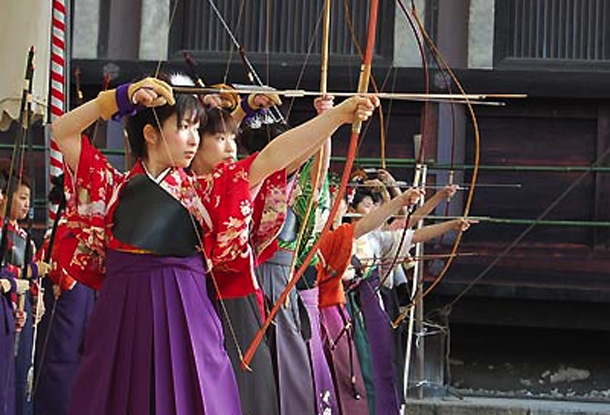
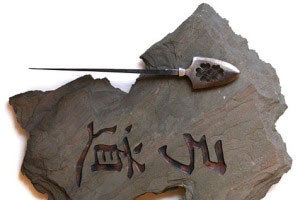


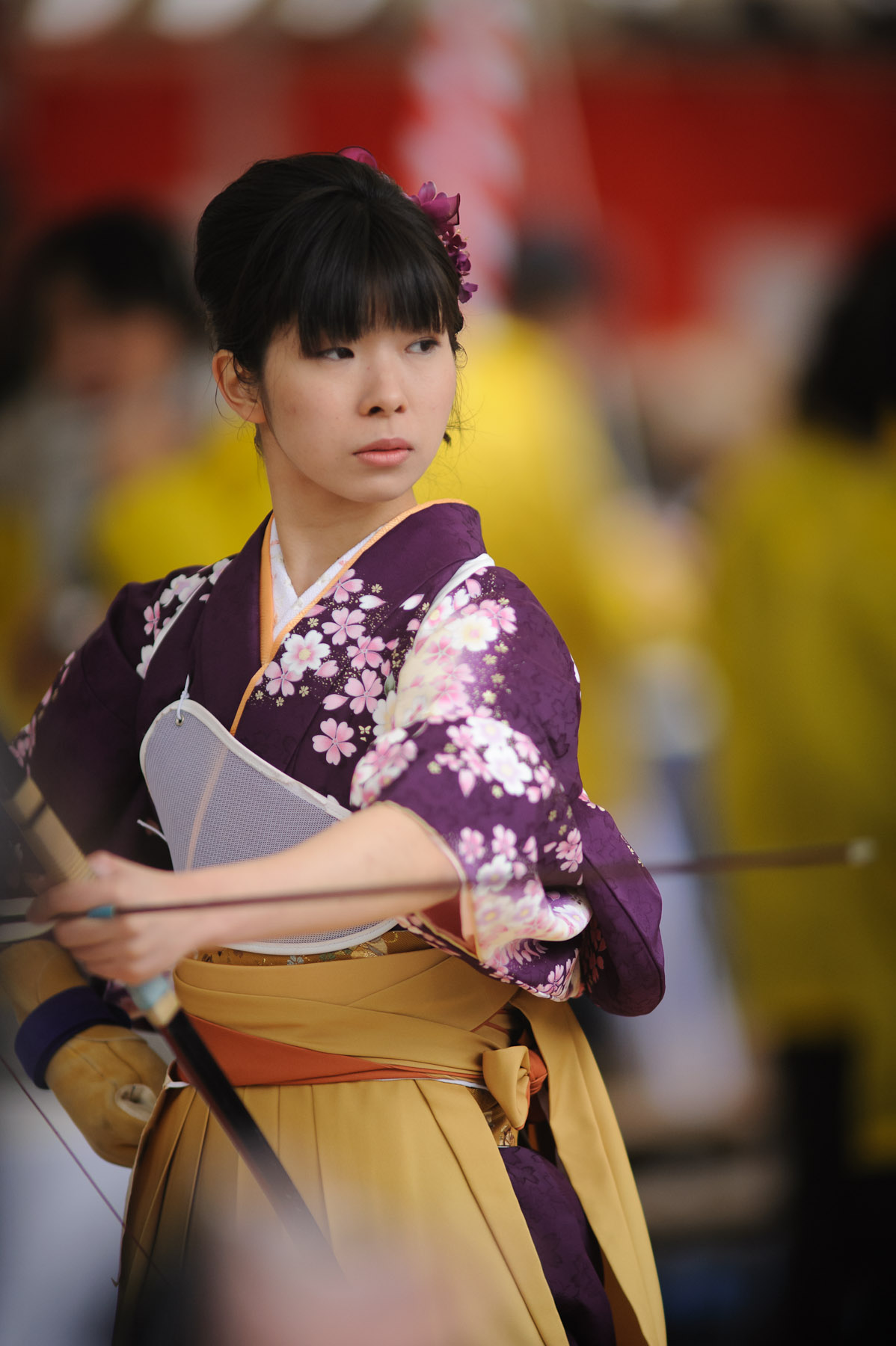
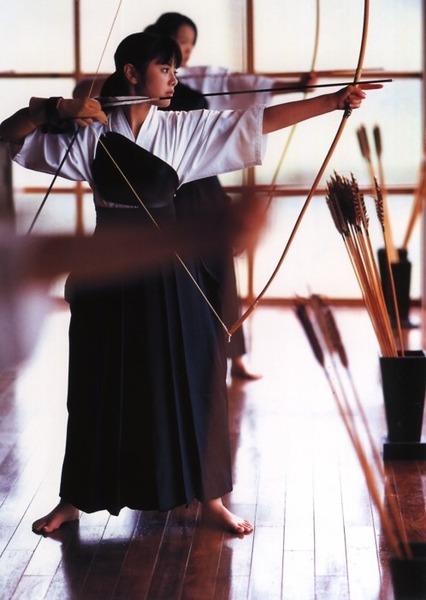












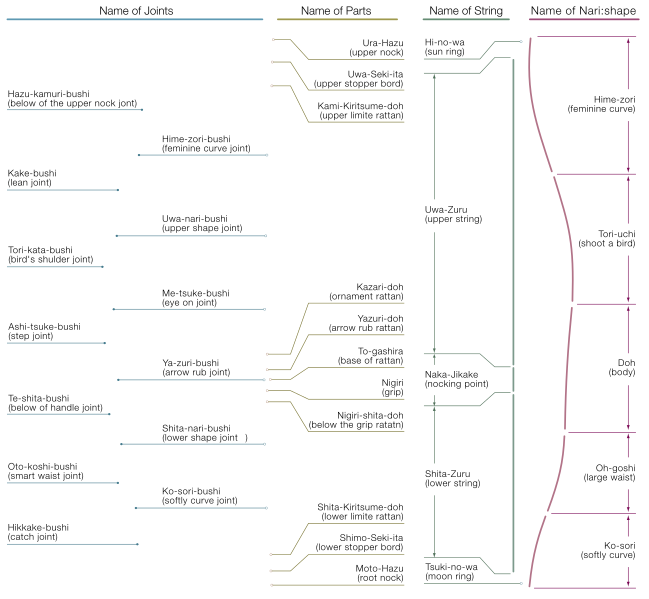
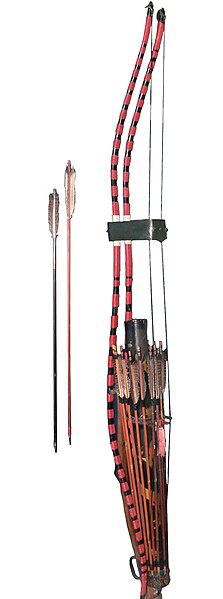

 حالت خطی
حالت خطی

